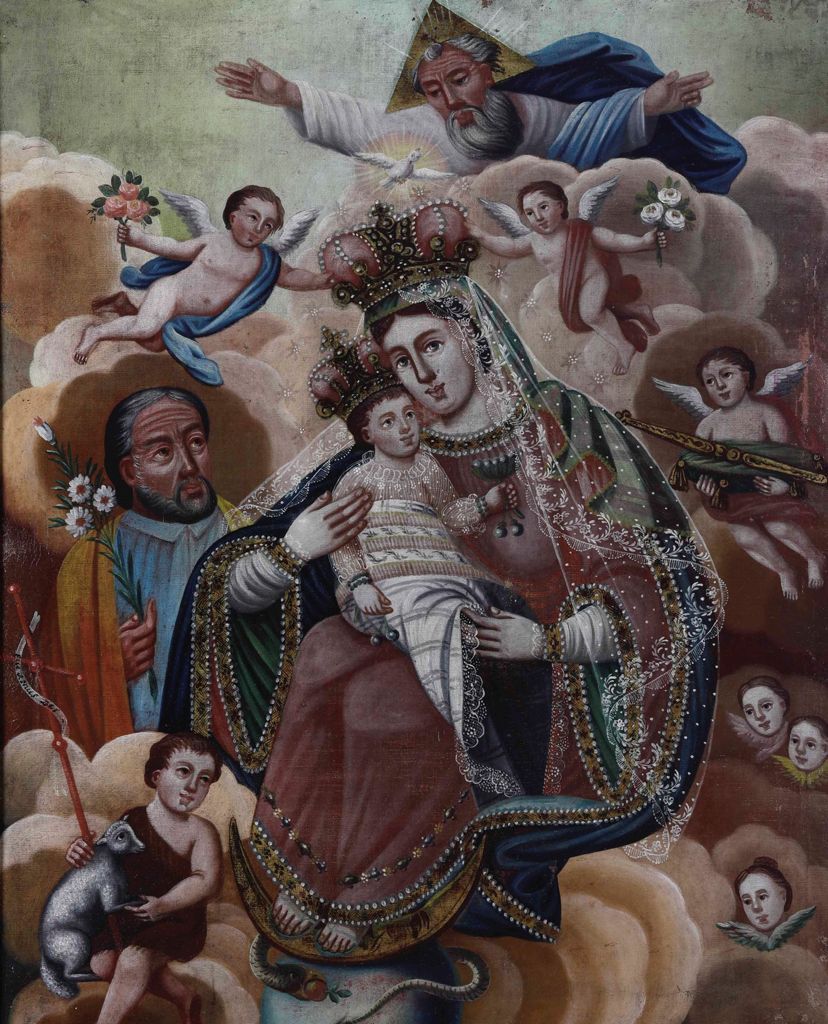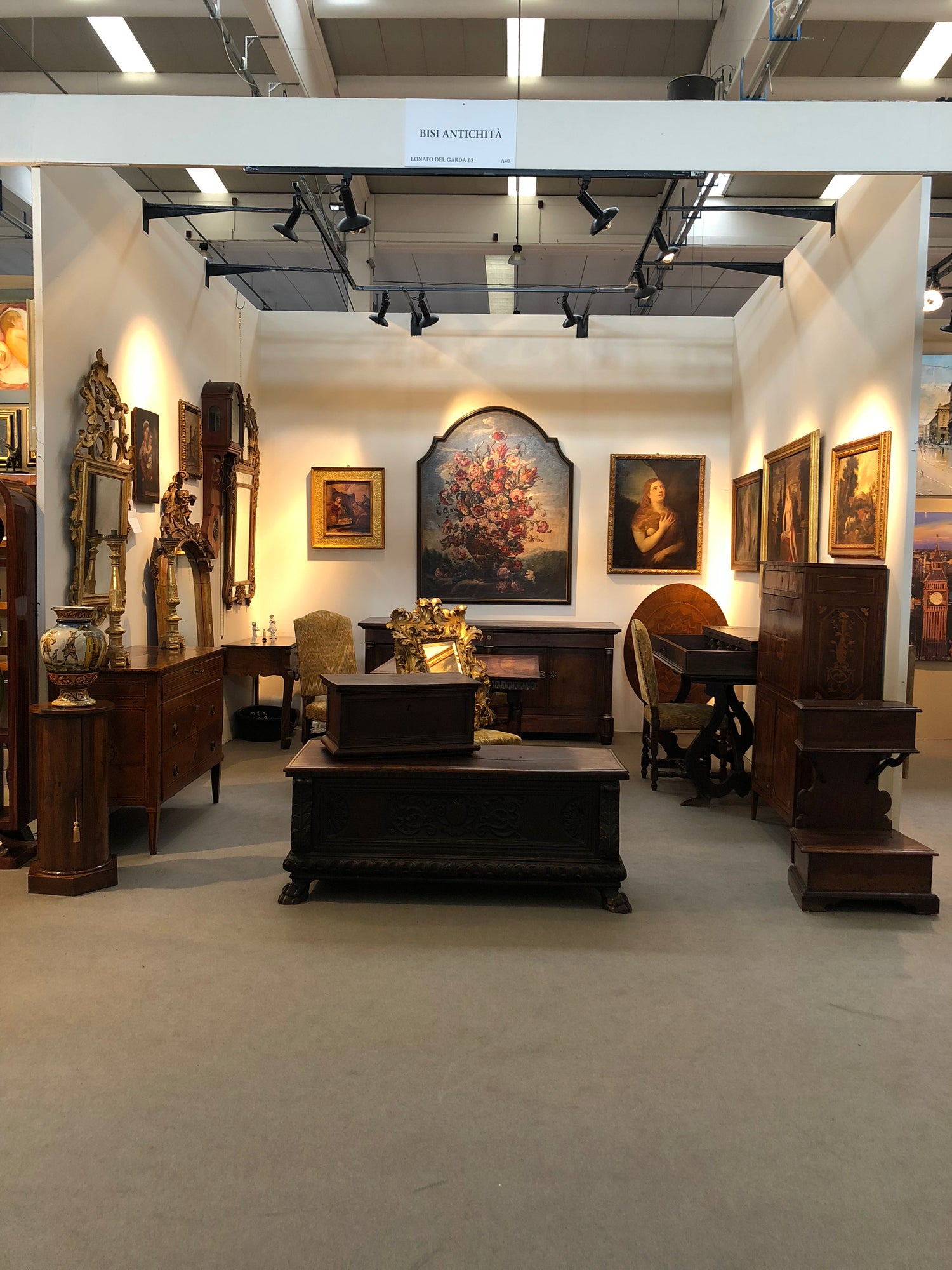Virgin and Child, Angels and Saints (Cuzco School, first half of the 18th century).
Virgin and Child, Angels and Saints (Cuzco School, first half of the 18th century).
The painting we are presenting constitutes, both for its intrinsic characteristics of pictorial technique, mainly focused on an intentional compression of dimensions and perspective effect, and for a widespread overabundance of the floral element, an eloquent testimony of the pictorial phenomenon belonging to the Andean cultural basin and better known as the "Cuzco school", the most important school of painting in America, which takes its name from the Peruvian city of the same name.
Its importance is first of all historical, as the Cuzco school arose to respond to the doctrinal needs, but also to the needs of inculturation, of the missionaries conquering the new world, who chose to convey the work of evangelization through the privileged channel of pictorial figurative art.
Thus, the colonizing impulse combined with an ostentatious proselytism, soon imposed the need, generated by the great demand for works of art, to train some local artists, works essentially inspired by the models of Italian Mannerism and Baroque. It is no coincidence that at the beginning, these were works performed by some Italian masters such as the Jesuit Bernardo Bitti, followed by Matteo Perez de Alessio and Angelino Medoro.
But it was Diego Quispe Tito (1611-1681) who was the most eminent personality of the Cuzco school, who was inspired above all by Flemish models, to whom he was a tributary in the choice of inserting the landscape into Peruvian painting by placing his sacred representations in the exotic setting characterised by tropical, imaginative vegetation, all pervaded by the intentional, almost paroxysmal search for distorted perspective.
It was thanks to the incisive work of Diego Quispe Tito that, gradually, the artists of Cuzco managed to free themselves from European models, abandoning the real world and moving into fairy tales.
This school, in the 18th century, influenced the painting of the entire Andean territory, standing out for the quantity and bizarre quality of the works of art produced. Thus the Andean Baroque, better known as the "mestizo style" began to depict Archangels wrapped in regal robes and holding firearms, precious decorations on all the clothes, rich necklaces and jewels on the Madonnas.
The aforementioned recovery of Flemish-Mannerist themes and effects was obtained through an aesthetic taste entirely marked by the wise obsessive search for archaism that was well suited to the indigenous mentality. The main purpose of the missionaries was in fact to compare and contrast the local deities with Christ, Mary and the Catholic Saints in order to reach an intuitive reciprocal identification, thus determining the consolidation of an ambivalent symbolism in the works of art of the Andean world.
In this way, at the same time, the maintenance and transmission of primitive and ancestral native rites was ensured, stimulating the creation of a precise local sacred iconography.
An authoritative testimony on the level of religious history is offered in this regard by our canvas, comparable in many respects to the Andean model of the Virgen de Pomata, the Andean equivalent of the European prototype of the Madonna of the Mountain, better and also known as the Madonna of Carmel.
El Cerro del Potosí, the celebrated archetype of the Great Mother in Bolivia, was venerated as the Reina, the Mother of all mountains, well before the arrival of the Conquistadors. This cult spontaneously merged with that of the Virgin who, having carried the Savior within herself, is the queen of all Mothers.
Now, this very “mountain” form of Mary is found in other Madonnas of the Andean region, first of all the aforementioned Virgen de Pomata, in which, as in our painting, the characteristic dress (dalmatic or cope), in addition to usually taking the shape of a mountain, presents as a constant one or more types of flowers (in our canvas also extended to a saint, to the right of the Virgin, and to the angels).
The figure of St. John the Baptist with the Agnus Dei placed at the bottom left of the observer arouses particular tenderness in the observer.
It is through works like this that indigenous culture managed to insert itself into the Western scheme, dragging with it the ideals of a submerged culture, but one that has never disappeared, as shown by the survival of this style, to which many artists of modern-day Cuzco continue to pay homage in a temporal continuum under the banner of the eternal present.
Measurements: 94 x 74
In case of sale, a written appraisal issued by Prof. Maturi Giorgio will be issued
EPOCH Thinking about making metafield with features
EPOCH Thinking about making metafield with features
Material
Materials
Materials
dimensions - transport or notes
dimensions - transport or notes
Share

Frequently Asked Questions
Things to know
The items are in their natural state
All our pieces are authentic and retain the signs of time that tell their story. This means that they may present small imperfections, signs of wear or original patina, which for us are an integral part of their charm and uniqueness.
We restore on request
Unless explicitly requested, we leave the signs of time and imperfections intact, to preserve the authenticity and soul of the antique object. However, if you want a restoration intervention, our team of experts is at your disposal to evaluate together the most suitable solution.
We work only and exclusively by appointment
Our service is exclusive and personalized: we receive only by appointment to guarantee you our full attention. Contact us to arrange a meeting and discover our collection in complete tranquility.
How does transportation work?
We offer different transport solutions, depending on the size and delicacy of the item. We rely on specialized professionals to ensure that each piece arrives at its destination in perfect condition. Contact us for more details or to request a personalized quote

QUALITY AND PASSION FOR GENERATIONS
Since the mid-19th century, our family has been working wood with dedication, transforming a small workshop in Poggio Rusco into a reality rooted on Lake Garda. Since 2014 , we have moved away from the family tradition of furniture production, orienting ourselves towards the restoration and search for ancient treasures to offer to our customers, keeping intact the values of authenticity and quality.

